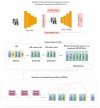Fine-Tuned Siamese Network with Modified Enhanced Super-Resolution GAN Plus Based on Low-Quality Chest X-ray Images for COVID-19 Identification
- PMID: 35328271
- PMCID: PMC8947640
- DOI: 10.3390/diagnostics12030717
Fine-Tuned Siamese Network with Modified Enhanced Super-Resolution GAN Plus Based on Low-Quality Chest X-ray Images for COVID-19 Identification
Abstract
Coronavirus disease has rapidly spread globally since early January of 2020. With millions of deaths, it is essential for an automated system to be utilized to aid in the clinical diagnosis and reduce time consumption for image analysis. This article presents a generative adversarial network (GAN)-based deep learning application for precisely regaining high-resolution (HR) CXR images from low-resolution (LR) CXR correspondents for COVID-19 identification. Respectively, using the building blocks of GAN, we introduce a modified enhanced super-resolution generative adversarial network plus (MESRGAN+) to implement a connected nonlinear mapping collected from noise-contaminated low-resolution input images to produce deblurred and denoised HR images. As opposed to the latest trends of network complexity and computational costs, we incorporate an enhanced VGG19 fine-tuned twin network with the wavelet pooling strategy in order to extract distinct features for COVID-19 identification. We demonstrate our proposed model on a publicly available dataset of 11,920 samples of chest X-ray images, with 2980 cases of COVID-19 CXR, healthy, viral and bacterial cases. Our proposed model performs efficiently both on the binary and four-class classification. The proposed method achieves accuracy of 98.8%, precision of 98.6%, sensitivity of 97.5%, specificity of 98.9%, an F1 score of 97.8% and ROC AUC of 98.8% for the multi-class task, while, for the binary class, the model achieves accuracy of 99.7%, precision of 98.9%, sensitivity of 98.7%, specificity of 99.3%, an F1 score of 98.2% and ROC AUC of 99.7%. Our method obtains state-of-the-art (SOTA) performance, according to the experimental results, which is helpful for COVID-19 screening. This new conceptual framework is proposed to play an influential role in addressing the issues facing COVID-19 examination and other diseases.
Keywords: COVID-19; Siamese network; adversarial learning; chest X-ray images; contrastive loss; deep learning; super-resolution.
Conflict of interest statement
The authors declare no conflict of interest.
Figures














Similar articles
-
COVID-19 Diagnosis from Chest X-ray Images Using a Robust Multi-Resolution Analysis Siamese Neural Network with Super-Resolution Convolutional Neural Network.Diagnostics (Basel). 2022 Mar 18;12(3):741. doi: 10.3390/diagnostics12030741. Diagnostics (Basel). 2022. PMID: 35328294 Free PMC article.
-
COVID-19 Identification from Low-Quality Computed Tomography Using a Modified Enhanced Super-Resolution Generative Adversarial Network Plus and Siamese Capsule Network.Healthcare (Basel). 2022 Feb 21;10(2):403. doi: 10.3390/healthcare10020403. Healthcare (Basel). 2022. PMID: 35207017 Free PMC article.
-
MetaCOVID: A Siamese neural network framework with contrastive loss for n-shot diagnosis of COVID-19 patients.Pattern Recognit. 2021 May;113:107700. doi: 10.1016/j.patcog.2020.107700. Epub 2020 Oct 17. Pattern Recognit. 2021. PMID: 33100403 Free PMC article.
-
Deep Learning Algorithm for COVID-19 Classification Using Chest X-Ray Images.Comput Math Methods Med. 2021 Nov 9;2021:9269173. doi: 10.1155/2021/9269173. eCollection 2021. Comput Math Methods Med. 2021. PMID: 34795794 Free PMC article.
-
Automated diagnosis of COVID-19 with limited posteroanterior chest X-ray images using fine-tuned deep neural networks.Appl Intell (Dordr). 2021;51(5):2689-2702. doi: 10.1007/s10489-020-01900-3. Epub 2020 Oct 17. Appl Intell (Dordr). 2021. PMID: 34764554 Free PMC article.
Cited by
-
How much BiGAN and CycleGAN-learned hidden features are effective for COVID-19 detection from CT images? A comparative study.J Supercomput. 2023;79(3):2850-2881. doi: 10.1007/s11227-022-04775-y. Epub 2022 Aug 26. J Supercomput. 2023. PMID: 36042937 Free PMC article.
-
COVID-19 Diagnosis from Chest X-ray Images Using a Robust Multi-Resolution Analysis Siamese Neural Network with Super-Resolution Convolutional Neural Network.Diagnostics (Basel). 2022 Mar 18;12(3):741. doi: 10.3390/diagnostics12030741. Diagnostics (Basel). 2022. PMID: 35328294 Free PMC article.
-
WMR-DepthwiseNet: A Wavelet Multi-Resolution Depthwise Separable Convolutional Neural Network for COVID-19 Diagnosis.Diagnostics (Basel). 2022 Mar 21;12(3):765. doi: 10.3390/diagnostics12030765. Diagnostics (Basel). 2022. PMID: 35328318 Free PMC article.
-
Artificial intelligence-assisted multistrategy image enhancement of chest X-rays for COVID-19 classification.Quant Imaging Med Surg. 2023 Jan 1;13(1):394-416. doi: 10.21037/qims-22-610. Epub 2022 Nov 10. Quant Imaging Med Surg. 2023. PMID: 36620146 Free PMC article.
References
-
- COVID-19 Map-Johns Hopkins Coronavirus Resource Center [Internet] [(accessed on 17 February 2022)]. Available online: https://coronavirus.jhu.edu/map.html.
-
- WHO Coronavirus (COVID-19) Dashboard|WHO Coronavirus (COVID-19) Dashboard with Vaccination Data [Internet] [(accessed on 17 February 2022)]. Available online: https://covid19.who.int/
-
- Rajpurkar P., Irvin J., Zhu K., Yang B., Mehta H., Duan T., Ding D., Bagul A., Langlotz C., Shpanskaya K., et al. Chexnet: Radiologist-level pneumonia detection on chest X-rays with deep learning. arXiv. 2017171105225
LinkOut - more resources
Full Text Sources
Research Materials

